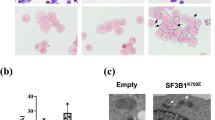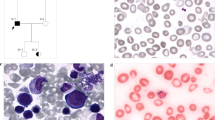Abstract
An isodicentric (X)(q13) (idicXq13) is a rare, acquired chromosomal abnormality originated by deletion of the long arm from Xq13 (Xq13-qter), and is found in female patients with hematological disorders involving increased ringed sideroblasts (RSs), which are characterized by mitochondrial iron accumulation around the erythroblast nucleus. The cause of increased RSs in idicXq13 patients is not fully understood. Here, we report the case of a 66-year-old female presenting with refractory anemia with ringed sideroblasts (RARS), and idicXq13 on G-banded analysis. We identify the loss of the ABCB7 (ATP-binding cassette subfamily B member-7) gene, which is located on Xq13 and is involved in mitochondrial iron transport to the cytosol, by fluorescent in situ hybridization (FISH) analysis and the decreased expression level of ABCB7 mRNA in the patient’s bone marrow cells. Further FISH analyses showed that the ABCB7 gene is lost only on the active X-chromosome, not on the inactive one. We suggest that loss of ABCB7 due to deletion of Xq13-qter at idicXq13 formation may have contributed to the increased RSs in this patient. These findings suggest that loss of the ABCB7 gene may be a pathogenetic factor underlying mitochondrial iron accumulation in RARS patients with idicXq13.






Similar content being viewed by others
References
Dewald GW, Pierre RV, Phyliky RL. Three patients with structurally abnormal X chromosomes, each with Xq13 breakpoints and a history of idiopathic acquired sideroblastic anemia. Blood. 1982;59:100–5.
Petit P, Fryns JP, Masure R, Berghe VH. Isodicentric (X)(q13): a new characteristic chromosomal anomaly in myeloproliferative syndrome? Cancer Genet Cytogenet. 1982;7:339–47.
Morgan RJ, Milligan DW, Williams J. Isodicentric X chromosome in a patient with myelodysplastic syndrome. Cancer Genet Cytogenet. 1987;27:215–8.
Mackinnon WB, Michael PM, Webber LM, Garson OM. Isodicentric X chromosome involving the Xq13 breakpoint in myelodysplasia and acute nonlymphocytic leukemia. Cancer Genet Cytogenet. 1988;30:43–52.
Dewald GW, Brecher M, Travis LB, Stupca PJ. Twenty-six patients with hematologic disorders and Xq13 anomalies associated with pathologic ringed sideroblasts. Cancer Genet Cytogenet. 1989;42:173–85.
Judith D, Lucinne M, Arnold C, et al. Isodicentric (X)(q13) in haematological malignancies: presentation of five new cases, application of fluorescence in situ hybridization (FISH) and review of the literature. Br J Haematol. 1995;91:885–91.
Paulsson K, Haferlach C, Fonatsch C, et al., on behalf of the MDS Foundation. The idic(X)(q13) in myeloid malignancies: breakpoint clustering in segmental duplications and association with TET2 mutation. Hum Mol Genet. 2010. [Epub ahead of print].
Shimada Y, Okuno S, Kawai A, et al. Cloning and chromosomal mapping of a novel ABC transporter gene (hABC7), a candidate for X-linked sideroblastic anemia with spinocerebellar ataxia. J Hum Genet. 1998;43:115–22.
Bekri S, Kispal G, Lange H, et al. Human ABC7 transporter: gene structure and mutation causing X-linked sideroblastic anemia with ataxia with disruption of cytosolic iron-sulfur protein maturation. Blood. 2000;96:3256–64.
Cavadini P, Biasiotto G, Poli M, et al. RNA silencing of the mitochondrial ABCB7 transporter in HeLa cells causes an iron-deficient phenotype with mitochondrial iron overload. Blood. 2007;109:3552–9.
Pondarre C, Campagna DR, Antiochos B, et al. Abcb7, the gene responsible for X-linked sideroblastic anemia with ataxia, is essential for hematopoiesis. Blood. 2007;109:3567–9.
Raskind WH, Wijsman E, Pagon RA, et al. X-linked sideroblastic anemia and ataxia: linkage to phosphoglycerate kinase at Xq13. Am J Hum Genet. 1991;48:335–41.
Allikmets R, Raskind WH, Hutchinson A, et al. Mutation of a putative mitochondrial iron transporter gene (ABC7) in X-linked sideroblastic anemia and ataxia (XLSA/A). Hum Mol Genet. 1999;8:743–9.
Malcovati L, Della Porta MG, Pietra D, et al. Molecular and clinical features of refractory anemia with ringed sideroblasts associated with marked thrombocytosis. Blood. 2009;114:3538–45.
Boultwood J, Pellagatti A, Nikpour M, et al. The role of the iron transporter ABCB7 in refractory anemia with ring sideroblasts. PLoS One. 2008;3:e1970.
Rack KA, Chelly J, Gibbons RJ, et al. Absence of the XIST gene from late-replicating isodicentric X chromosomes in leukaemia. Hum Mol Genet. 1994;3:1053–9.
Heard E. Recent advances in X-chromosome inactivation. Curr Opin Cell Biol. 2004;16:247–55.
Harris NL, Jaffe ES, Diebold J, et al. The World Health Organization classification of neoplastic diseases of the hematopoietic and lymphoid tissues. Report of the Clinical Advisory Committee meeting, Airlie House, Virginia, November, 1997. Ann Oncol. 1999;10:1419–32.
Greenberg P, Cox C, LeBeau MM, et al. International scoring system for evaluating prognosis in myelodysplastic syndromes. Blood. 1997;89:2079–88.
Willard HF, Breg WR. Human X chromosomes: synchrony of DNA replication in diploid and triploid fibroblasts with multiple active or inactive X chromosomes. Somatic Cell Genet. 1980;6:187–98.
Brown CJ, Ballabio A, Rupert JL, Ronald G, et al. A gene from the region of the human X inactivation centre is expressed exclusively from the inactive X chromosome. Nature. 1991;349:38–44.
Payer B, Lee JT. X chromosome dosage compensation: how mammals keep the balance. Annu Rev Genet. 2008;42:733–72.
Lucchesi JC, Kelly WG, Panning B. Chromatin remodeling in dosage compensation. Annu Rev Genet. 2005;39:615–51.
Fleming MD. The genetics of inherited sideroblastic anemias. Semin Hematol. 2002;39:270–81.
Casas K, Bykhovskaya Y, Mengesha E, et al. Gene responsible for mitochondrial myopathy and sideroblastic anemia (MSA) maps to chromosome 12q24.33. Am J Med Genet A. 2004;127:44–9.
Yoon SY, Kim JM, Oh JH, et al. Gene expression profiling of human HBV- and/or HCV-associated hepatocellular carcinoma cells using expressed sequence tags. Int J Oncol. 2006;29:315–27.
Greenberg PL, Young NS, Gattermann N. Myelodysplastic syndromes. Hematology Am Soc Hematol Educ Program. 2002;1:136–61.
Author information
Authors and Affiliations
Corresponding author
About this article
Cite this article
Sato, K., Torimoto, Y., Hosoki, T. et al. Loss of ABCB7 gene: pathogenesis of mitochondrial iron accumulation in erythroblasts in refractory anemia with ringed sideroblast with isodicentric (X)(q13). Int J Hematol 93, 311–318 (2011). https://doi.org/10.1007/s12185-011-0786-y
Received:
Revised:
Accepted:
Published:
Issue Date:
DOI: https://doi.org/10.1007/s12185-011-0786-y




